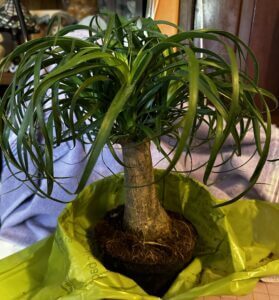The Ponytail Palm
I wanted to do this blog post on a plant I received to review; etc.
I will be doing a full review in a few weeks, to giving me a few weeks to check out the plant, etc.
The plant is called Ponytail Palm and when I received it. it was in a big box and very well protective.
I got it out of the box, and it was so lovely. I decided to let it stay in the same pot for a bit, it came in a 6″ pot. you don’t have to transplant it until it’s outbound, rootbound from what I read so I can wait until I find a nice pot. I keep playing with the leaves 🙂 I love this plant.
So here is some information about the ponytail palm and how to take care of it.
First, let’s start with what is a Ponytail Palm.
A Ponytail palm, scientifically known as Beaucarnea recurvata, is a popular plant known for its unique appearance and low maintenance requirements. With its long, slender leaves cascading from a thick, bulbous trunk, the ponytail palm adds an elegant touch to any indoor or outdoor space. This drought-tolerant plant is a great choice for those looking to add a touch of greenery to their surroundings without the hassle of constant care and attention. Ponytail Palm
The ponytail palm can grow to 2 – 3 feet in your home.
Watering Frequency
Indoor ponytail palms should be watered less frequently than outdoor ones due to the controlled environment. During the active growing season (spring and summer), water your indoor ponytail palm every four to six weeks or when the top inch of the soil feels dry to the touch. It’s crucial not to overwater; excessive moisture can lead to root rot. Additionally, make sure the pot has proper drainage to prevent water from accumulating at the bottom.
Winter Dormancy
Ponytail palms often go through a period of dormancy in the fall and winter, during which they require less water. Reduce watering to once every eight weeks or when the soil’s top layer dries out during this dormant phase. Overwatering during dormancy can lead to root rot, so it’s crucial to adjust your watering schedule accordingly.
Signs of Thirst
Observe your ponytail palm for signs of thirst. If the lower leaves start to turn yellow or droop, it may be an indication that the plant needs water. However, it’s essential not to jump to conclusions. Always check the moisture level of the soil before watering.
Air Purification
Apart from their aesthetic appeal and ease of care, ponytail palms provide an additional benefit as natural air purifiers. Like other indoor plants, they help improve indoor air quality by absorbing pollutants and emitting oxygen. This not only enhances the ambiance of your living space but also contributes to a healthier environment for you and your family.
Indoor Ponytail Palms
Place your indoor ponytail palm near a window with filtered or indirect sunlight. If direct sunlight is too intense, it can scorch the plant’s leaves. South or west-facing windows are often ideal. Rotate the pot periodically to ensure even exposure to light, promoting balanced growth.
Soil
Use a well-draining potting mix for your ponytail palm. A mix designed for cacti or succulents is suitable. Good drainage is critical to prevent waterlogged roots, which can lead to rot. You can also add perlite or sand to the potting mix to enhance drainage further.
Pot Selection
Choose a pot with drainage holes at the bottom to facilitate excess water drainage. Ponytail palms prefer slightly crowded conditions, so select a pot that is just large enough to accommodate the plant’s root system. Repotting is infrequent and typically only required when the plant becomes root bound.
Fertilizing
Fertilizing is an essential aspect of ponytail palm care, contributing to healthy growth and foliage.
Frequency
During the growing seasons, which usually include the entirety of spring and summer, provide your ponytail palm with a balanced, diluted, organic liquid fertilizer every six to eight weeks or so. Reduce or eliminate fertilization during the fall and winter when the plant enters a period of dormancy.
Root Rot
overwatering can lead to root rot. If you have a feeling that your plant has root rot. take out the plant from its pot, prune away the diseased roots, and replant it in fresh, well-
draining soil in a new pot.
I will be doing a full review of the ponytail palm houseplant in a few weeks, as I want to have the plant first for a bit before I do a full review.
So please come back then to see what I think of this plant. 🙂 I’m sure it’s going to be wonderful 🙂
You can get your own ponytail palm just like I have at My Perfect Plants












